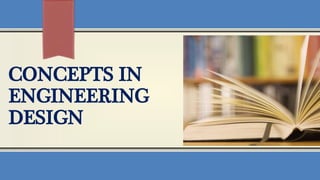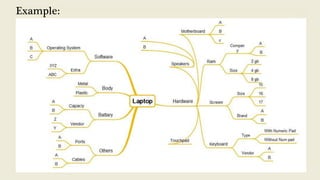Concepts in engineering design
- 2. Course Objective The course intends to develop the feel of design and development of a real product It is an interdisciplinary course on Product Development and you may graduate into any domain. The course intends in developing understanding on the issues mentioned earlier and executes projects to execute principles of product design. The course intends to work on “artifact design” or “design of a solution” – by no means, it intends towards “technology design”
- 10. What is Engineering Design? The subject of 'Engineering' can be divided into two activities of analysis and synthesis. Analysis (& research) is really Science or the study of materials, actions, life etc. to better understand our world. We can call it 'Engineering Science' if the study focuses on materials, processes and material actions. However, when we start taking this knowledge and applying it to improve the quality of life we are synthesizing knowledge. We are now being creative with our knowledge. This is DESIGN and is FUNDAMENTAL to ENGINEERING.
- 11. Engineering is the application of science to problem solving. Design is the creative expression of knowledge...
- 12. VISION Product Design requirements include: • creative minds, • synthesis of varied knowledge domains • innovative solutions • Interactivity And above all A passion for design!
- 13. NEED For DESIGN… As our world shrinks rapidly with technologies spreading freely without borders, people's demands get more complex. To resolve these newer complexities, deep understanding in each relevant field or domain is required.
- 14. WHY OUTSOURCING FOR PRODUCT DESIGN? Four Reasons • Capacity • Speed • Expertise • Innovation
- 15. Importance of Engineering design Decisions made in the design process cost very little in terms of the overall product cost but have a major effect on the cost of the product. You cannot compensate in manufacturing for defects introduced in the design phase. (The design must be carried out so that the product can be made without defect at a competitive cost.) The design process should be conducted so as to develop quality, cost-competitive products in the shortest time possible. (the longer a product is available for sale the more sales and profits there will be. )
- 16. Product cost commitment during phases of the design process.
- 17. Product Life Cycle Costs
- 18. The Four C’s of Design Creativity ● Requires creation of something that has not existed before or has not existed in the designer’s mind before Complexity ● Requires decisions on many variables and parameters Choice ● Requires making choices between many possible solutions at all levels, from basic concepts to the smallest detail of shape Compromise ● Requires balancing multiple and sometimes conflicting requirements
- 19. Types of Design Original design, also called innovative design. This form of design is at the top of the hierarchy. It employs an original, innovative concept to achieve a need. Sometimes, but rarely, the need itself may be original. A truly original design involves invention. The design of the microprocessor was one such original design. Adaptive design. This form of design occurs when the design team adapts a known solution to satisfy a different need to produce a novel application. For example, adapting the ink-jet printing concept to spray binder to hold particles in place in a rapid prototyping machine.
- 20. Types of Design Redesign. Much more frequently, engineering design is employed to improve an existing design. The task may be to redesign a component in a product that is failing in service, or to redesign a component so as to reduce its cost of manufacture. Often redesign is accomplished without any change in the working principle or concept of the original design. When redesign is achieved by changing some of the design parameters, it is often called variant design. Selection design. Most designs employ standard components such as bearings, small motors, or pumps that are supplied by vendors specializing in their manufacture and sale. Therefore, in this case the design task consists of selecting the components with the needed performance, quality, and cost from the catalogs of potential vendors.
- 21. Types of Design Industrial design. This form of design deals with improving the appeal of a product to the human senses, especially its visual appeal. While this type of design is more artistic than engineering, it is a vital aspect of many kinds of design. Also encompassed by industrial design is a consideration of how the human user can best interface with the product.
- 22. A Simplified Iteration Model (1) exploring the alternative concepts that could satisfy the specified need, (2) formulating a mathematical model of the best system concept, (3) specifying specific parts to construct a subsystem, and (4) selecting a material from which to manufacture a part.
- 23. Basic module in the design process.
- 24. Comparison between the scientific method and the design method.
- 25. Various Ways to think about Design Photography Visualization Brainstorming
- 26. Brainstorming One idea at time Encourage wild ideas Go for quantity Be visual Headline Go for other ideas Defer judgement Marking and shifting
- 27. Example:
- 31. Communication of the results Evaluation of alternatives and decision making Generation of alternative solutions Gathering of information Definition of the problem A Problem Solving Methodology
- 39. Gathering Information The following are some of the questions concerned with obtaining information: What do I need to find out? Where can I find it and how can I get it? How credible and accurate is the information? How should the information be interpreted for my specific need? When do I have enough information? What decisions result from the information?
- 40. Generation of Alternative Solutions Generating alternative solutions or design concepts involves the use of creativity, stimulation methods, the application of physical principles and qualitative reasoning, and the ability to find and use information. Of course, experience helps greatly in this task. The ability to generate high-quality alternative solutions is vital to a successful design.
- 41. Evaluation of Alternatives and Decision Making The evaluation of alternatives involves systematic methods for selecting the best among several concepts, often in the face of incomplete information. Engineering analysis procedures provide the basis for making decisions about service performance. Design for manufacturing analyses and cost estimation provide other important information. Various other types of engineering analysis also provide information. Simulation of performance with computer models is finding wide usage
- 42. Evaluation of Alternatives and Decision Making An important activity at every step in the design process, but especially as the design nears completion, is checking. In general, there are two types of checks that can be made: mathematical checks and engineering-sense checks.
- 43. Communication of the Results It must always be kept in mind that the purpose of the design is to satisfy the needs of a customer or client. Therefore, the finalized design must be properly communicated, or it may lose much of its impact or significance.












































